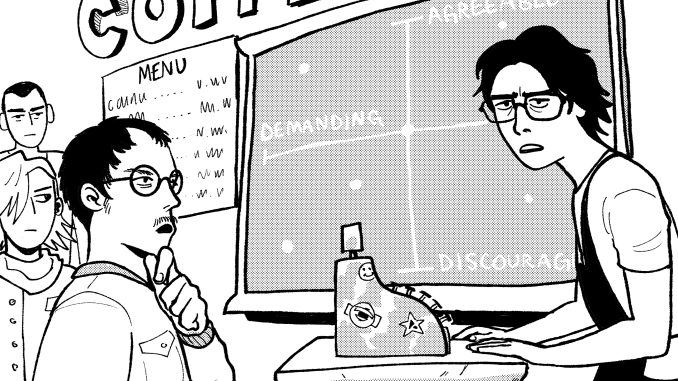
Shea Stevenson
I’ve noticed a lot of concern among my peers regarding how to “properly” order coffee, and as a former professional barista myself, I think the answer may be as enlightening as it is terrifying. It’s a new frontier of communication, one you might never practice besides when you need to order something. But for a barista, who’s forced to hear and speak this language for hours a day, they have no choice but to notice, hone, and perfect how to articulate orders. It has mores and folkways, high class and low class, it has everything you would need to know about a person in their first sentence.
First, to lay the groundwork, there is only one useful metric of an order’s success: did you get the thing you wanted? Maybe you want it fast, maybe there’s no rush. The only thing that actually matters is that you made some utterances at me, I properly interpreted them, and was able to fulfill your request within a timeframe you found reasonable. Everything else I am about to say is towards a more clear actualization of that idea: what do you want? When do you want it? What kind of person are you?
There are two axes regarding order-starters: pathetic to demanding and appreciated to discouraged. We’ll get to extremes in a moment, but for now, the bottom line: what is the most normal and invisible way to order?
If you don’t know what type of order-starter works best for your personality, the exact midpoint of this spectrum is “I’d like a –.” As a shortening of “I’d like to have a –,” this is an easy to understand, not too demanding (completely normal amount of assertiveness) but not too pathetic (you know how a coffee shop works, you aren’t asking a question, you’re telling me what you want). Overall, it’s a useful go-to. Not to mention, it revolves around a nice word! “Like!” It has an heir of agreeability, of pleasure in this interaction to some extent, or at least enjoyment of the product. Solid “A” for most people.
I find myself, much to my dismay, using one of the most dangerous order-starters out there when I’m on the dark side of the cash register. “I’ll just have –” has two main forms, one where you’re only ordering one thing (this one is good), and another where you’re ordering multiple things (this one is unforgivable). You will not “just” have a cappuccino and… uh… hm… maybe a cortado. Ridiculous! You can often get away with two things if at least you say them fast and act as if they’re essentially linked, for example, “I’ll just have a small coffee and a roll.” Beautiful.
The most pathetic and also most discouraged way to order is “is it possible to get a –.” Unless you’re talking about something you either haven’t found on the menu or is genuinely bizarre as a thing to be asking for, then yes, it is possible to make a cappuccino. I do have green tea. If it’s on the menu you can have it, and if it’s not, I’m sure it’s still possible. It is couched in rhetoric so unsure of itself that it can’t even declare its desire, framing it as some perverse half-question where it takes the form of an uncertainty but we both know that it’s a demand. And as a demand, I am code-bound to fulfill it. This starter does not accept its own role in the interaction. It is scared of itself.
This last one I urge my readers not to try at home without rigorous practice and forethought, both towards delivery and towards whether or not your demeanor is fundamentally fit to handle it. My favorite way to order is also the most demanding; no preamble, just the order. I say “Hello,” and you say, “small black coffee.” Superb. We’re done. It is totally sure of itself, understanding of its position in the conversation, and leaves no room aside from delivery to be rude or polite – it is what it is. Only an order. Done properly, this is invisible. I don’t think about it at all, I only set to work on the order. If done too carefully or haltingly, I realize the act; you are not so sure of yourself. Perhaps you’re trying to sound decisive and cool, but now your bid for expediency betrays you, and you’ve outpaced your ordering thoughts. If done too quickly or without enough information to complete the order (i.e., “coffee”), then the whole thing breaks down again. I snap the illusion by asking a question to clarify the order, the only thing you even said, and now you have to say something else.
Consider carefully and order well. Remember, the best order is one I forget as soon as I give you the drink. Explore, find your proper order, and use it until it sounds stupid.
